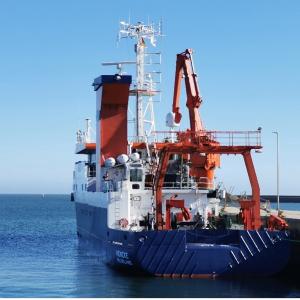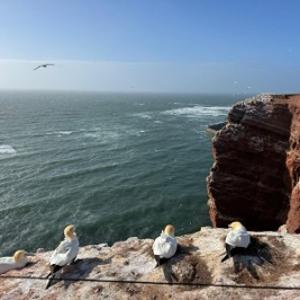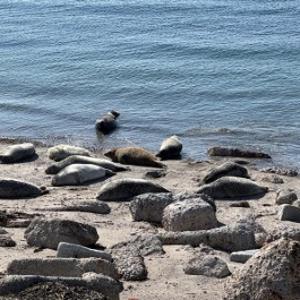Heincke Expedition North Sea 2025
Rowan Brown, 29 May 2025

Rowan Brown, 29 May 2025

Eight students from the Department of Geography at LMU Munich set sail this March aboard the Alfred Wegener Institute’s (AWI) Research Vessel Heincke as part of a small excursion led by Prof. Dr. Alexander Haumann and chief scientist Dr. Wilken-Jon von Appen. Joined by students from HHU Düsseldorf and Uni Bremen, they spent five days from March 29 to April 2 experiencing life as ocean-going research scientists studying the physics, biology, and biogeochemistry of the North Sea and the German Bight.
Following is a day-to-day overview of the excursion, in the students’ own words.
On the first day, we checked out of the hostel in Bremerhaven and boarded the Heincke. On board we were immediately able to observe a partial solar eclipse; a student from Bremen had built an apparatus (first image below) the evening before in order to be able to see the solar eclipse.
After we boarded and left the harbour, we were introduced to the measuring equipment on board. In the second image below we are preparing a CTD rosette and in the third image we are being introduced to the preparation of a mooring. A mooring is a device that is lowered into the water at a location, where it measures various parameters such as temperature and electrical conductivity, and is then retrieved again after a period of time. It has to be programmed first. We also carried out the first test measurement with the CTD rosette and took water samples from the attached Niskin bottles in addition to temperature, salinity, and chlorophyll concentration measurements from the sensors.
Working on a research vessel for longer time periods means to combine work, leisure, and hobbies all in one place. With scientific research a life on board a research vessel also brings other responsibilities such as cleaning the dishes after meals. A good night's sleep is important! Especially after a hard day's work. That's why the Heincke also offers sleeping areas for scientists and crew, with additional accommodations at the AWI guesthouses on the island of Helgoland.

© S. Lang, K. Hartl
One of the highlights of the excursion was the tour of Helgoland that we undertook on Sunday. We not only learned about the local history and the intertwining of nature and people on the island, but also about the geological background. The special geological and geographical position of the island has made it an important economic and strategic hub. It was particularly inspiring to see how seriously nature conservation is taken on Helgoland.
On Monday, we experienced quite the adventure on our ship. The storm from the day before had left us but the wind was still strong. The remnants of the storm were waves that caused the ship to move quite a bit. Despite these challenging conditions, the highlight of the day was definitely the two sediment samples we collected from the sea floor.
The first sample came from an area with muddy ground. The second was taken from a location with more sandy ground. We first analysed the structure of the samples and we even looked for wildlife in the second sampling. We worked together with the biology students from the University of Düsseldorf to get further information about the animals we found in the sediment sample. And we got lucky! We found two baby clams, a shrimp, and even a small starfish. We took a closer look at them under a microscope before releasing them back into the ocean.
Overall, it was a great hands-on experience that not only taught us about geography but also about the biodiversity of the seafloor.
On Monday, we elected a lead scientist who coordinated today’s route with all the working groups. The goals of our working groups, their measurement methods, and the planned waypoints were incorporated into the plan. The schedule was checked for feasibility with the ship’s crew and captain. In the morning it was approved.
The day was now planned for everyone. The appointed lead scientist, Robin Matz, was our main decision-maker. The lecturers and supervisors supported us throughout the day, but the responsibility for execution and timing lay with us students. Thus, the Heincke's voyage proceeded from waypoint to waypoint. Each student group applied their chosen methods to collect data. For example, the mooring was recovered, and the sensor data was secured and processed. The CTD was used at all eight stations. The student groups gave the radio commands themselves and determined the depth of each sample taken.
The multi-net was also explained to us today. It can be used to collect zooplankton at different water depths. It consists of several nets that can be closed and opened one after the other. The net is lowered to the greatest depth and then pulled up the water column. The nets are opened one after the other, so that the zooplankton from the different depths is in the sample cups at the end.
In addition to the research tasks, we also carried out sample collection, filtration, storage, and the re-setup of the CTD. The students had already been divided into rotations for these tasks. Between the sometimes longer trips from station to station, the lecturers and supervisors used the breaks to present and familiarize us with current research, data collection, and measurement methods from the fields of ocean biology, biogeochemistry, and physics. The rest of the day was characterized by an intense exchange among the students about the contents of their presentations and research. The day was diverse and spent on various exciting applications and research tasks.
Despite the heavy workload, there were always quieter moments – whether for explaining concepts, exploring the ship, or taking a break while enjoying the view of the North Sea or the island of Helgoland.
Overall, despite the workload, there was never a sense of downtime, and the excursion was, in many ways, educational, exciting, and without exaggeration, a unique experience.

© S. Lang, K. Hartl
Wednesday represented the culmination of the excursion, with a morning dedicated to student presentations followed by a final opportunity to explore Helgoland before beginning the long journey back to Munich. The students' presentations covered a range of topics, from a survey of North Sea plankton species to an explanation for how the previous days' storm affected the circulation in the German Bight. Each presentation was an impressive tour de force of just how much the students had learned in 4 short days.
After putting in so much hard work, most of the students spent the afternoon lounging on the sea wall with some of the Helgoland locals (pictured right). Eventually it was time to head home to Munich, starting with a high-speed ferry ride to the mainland followed by an ÖBB nightjet train from Hamburg to Munich.